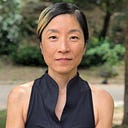Asian hate. Why now?
By J. Robin Moon
Since the shooting spree in Atlanta on March 16, I have been getting many questions from my non-Asian friends and colleagues: “Why is this happening now? This is new to us.”
Although there has been a 150% increase in Asian assaults since the pandemic, and many in the media represent these incidents as motivated by “Kung Flu” rhetoric, the history of Asian hatred, violence and lynching is as long as the modern American immigration story itself.
COVID-19 has merely magnified and brought to the fore the detrimental, unignorable impact of long-standing, systemic inequities and structural racism. The Atlanta shooting is another striking example of such racism that has been decades in the making and festering underground.
In the modern US immigration history, the very first group barred from the US were Asian immigrants. The 1875 Page Act was the first federal immigration law and prohibited the entry of immigrants considered as “undesirable.” The law classified as “undesirable” any individual from Asia who was coming to America as a contract laborer. The 1882 Chinese Exclusion Act, and a series of laws following, allowed the expulsion of a massive number of Chinese from the US.
Since then, Asian Americans have long suffered offensive and false stereotypes, promoted largely by the media. We are the hard-working but money-hoarding, tiger moms whose kids invade Ivy League schools, yet racially inferior, submissive and docile, invisible, silent people who are comfortable with being so.
A year after the 1965 Immigration Act, which allowed a preferential, merit-based approach to immigration, the term “model minority” was coined by sociologist William Petersen. He attributed the apparent success of Japanese Americans, only 20 years after their World War II incarceration in internment camps, to their cultural values, strong work ethic, family structure, and genetics.
The “model minority” analysis pitted Japanese Americans — and, later, all Asian Americans — against so-called “problem minorities,” which put wedges between Asian and Black communities, and also masked the wide disparities among diverse Asian Americans and Pacific Islanders groups in terms of income, employment, education, health, housing, and immigrant experience. Perhaps the most important consequence, it distracted the white-Black conflict from charges of structural racism, and placed ethnoracial conflicts in tandem with, not as part of, structural racism.
The uncomfortable truth is that much of this wave of anti-Asian violence has come from Black and Latinx groups. Another uncomfortable truth is the extent to which the Asian American community has been complicit in aspiring to “whiteness” and being prejudiced against other ethnoracial groups, instead of carving out our own identity.
Many Asian Americans, wedged between the white majority and other minorities, did not make allies with Blacks and Latinx while aspiring to be successful like whites, all the while not realizing that whites do not accept us on our own terms, either.
The Los Angeles, Crown Heights and Washington Heights Civil Unrests in the 1990s laid bare the fissures in America’s post-industrial, service-based economy that had created marginal and inequitable opportunities for new immigrants (i.e., Asian), and heightened economic hardships for native-born minorities including Black and Latinx groups.
These conditions have often been presented as “new fault lines” in urban race relations beyond the civil rights paradigm of white and Black relations. What’s more, the COVID-19 pandemic playing out on an unlevel playing field as a consequence of structural racism, the murders of our Black community members, and the political turmoil surrounding the pandemic under the last administration make for racial trauma “competition” — whose trauma is greater? Which damage is more severe? Whose lives matter more?
In the aftermath of the Civil Unrests of the 1990s and faced with unprecedented ethnoracial diversity in our cities, various immigrant groups across the country started inter-ethnic dialogues, community-driven programs and public policy coalitions through multicultural collaboratives and cooperatives. These initiatives created opportunities for community stakeholders to build trusting personal relationships and social ties, and discuss a shared vision of their respective cities and how to build political power as a new majority of racialized peoples combined.
On the one hand, the Atlanta shooting disheartens us because these efforts seem to have been in vain: neither further acknowledged, nor progressed. On the other hand, we must realize that this crime is just one more marker (though a big one) of a generation-old problem that we need to continue pushing to address. We must:
● Expand the civil rights agenda to include race relations and immigration reform.
● Cultivate strong community-based non-profit institutions to support local initiatives, inter-ethnic alliances and capacity building to engage in bridging social capital (i.e., inter-community collaborations).
● Invest in youth development and new urban leadership through mentorship, education, and employment opportunities.
● Promote the collection of more and better data that appropriately represent our populations’ demographic, socioeconomic, and political landscape.
The ties that bind various immigrant groups — new and old — include a history of migration (voluntary or forced), contributions of innovation and resourcefulness, sharing the same city as home, and a desire to make our community a better place. We must recognize the linked fates of our diverse communities, and grow personal relationships and trust among diverse community leaders and stakeholders. We need to continue promoting a culture of engagement and inclusion, and recognize the need for cultural humility that includes language and our unique ethnoracial history.
We, Americans regardless of color, must denounce prejudice and become a diverse group of anti-racists together. It is not just for the white-Black conflict. We must reject a binary path — siding with white majority or other “minorities” — but seize the moment out of our own initiative and power, not relying and being beholden to the white power structure. And understanding and acknowledging the long history of anti-Asian aggression as part of structural racism and white supremacy, without trying to “out-trauma” one other, is how we begin to find solutions.
